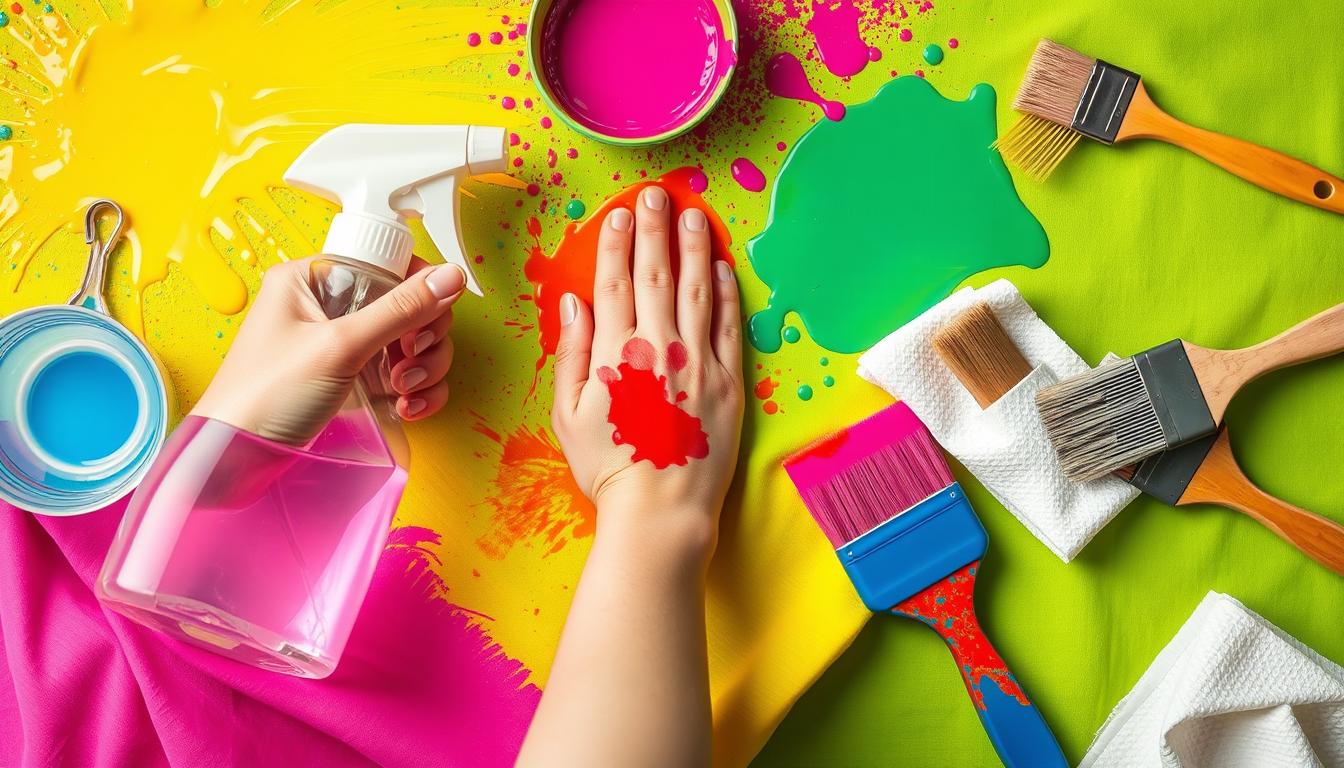Paint stains can ruin your favorite clothes fast. Since 90% of paint stains are water-based, knowing how to remove them is key. It’s important to act fast – experts say treat stains within 5 minutes for the best chance.
If you’re an artist, DIY lover, or just had a paint accident, this guide is for you. It covers how to remove paint from clothes. Every stain is different, but with the right steps, you can save your clothes and avoid damage.
Key Takeaways
- Act quickly when paint spills occur
- Identify the type of paint before treatment
- Use appropriate cleaning techniques for different fabric types
- Avoid heat when treating paint stains
- Pre-treat stains before washing
- Test cleaning solutions on small, hidden areas first
Understanding Different Types of Paint Stains
Paint stains can be a big problem for anyone working on home projects or crafts. It’s important to know the different types of paint stains to remove them well. Each paint type needs a special way to get rid of stains from clothes.
There are three main types of paint stains, each with its own removal process:
- Water-based paints
- Oil-based paints
- Specialty spray paints
Water-Based Paints: Latex and Acrylic
More than 70% of home paints are water-based. Latex and acrylic paints dry fast and are easy to clean up. They are usually easier to remove than other types.
Oil-Based Paints
About 30% of craft paints are oil-based. These stains are harder to remove because of their makeup. You need special solvents and methods to get rid of oil-based stains.
| Paint Type | Removal Difficulty | Recommended Treatment |
|---|---|---|
| Water-Based (Latex) | Easy | Soap and water |
| Acrylic | Moderate | Rubbing alcohol |
| Oil-Based | Difficult | Paint thinner |
Spray Paints and Special Formulations
Spray paints have their own set of challenges. They have complex chemicals that need special removal methods. Act fast – 60% of stains are removed in the first 5 minutes.
“Understanding your paint type is the first step to successful stain removal”
It’s key to know the paint type before trying to remove a stain. The chemical makeup of each paint tells you the best cleaning method. This increases your chances of removing the stain completely.
Essential Supplies for Paint Stain Removal
Having the right supplies for paint stain removal is crucial. Quick action and the right tools are key to removing stains before they set in.
- White vinegar
- Rubbing alcohol
- Liquid dish soap
- Warm water
- Clean white cloths
- Soft-bristled brush
- Tide Ultra Stain Release detergent
Different paints need different treatments. Acting fast can boost removal success by over 70%. Knowing which supplies work best for each paint type is important.
| Paint Type | Recommended Supplies | Removal Success Rate |
|---|---|---|
| Latex Paint | Warm water, dish soap | 70% |
| Oil-Based Paint | Rubbing alcohol, acetone | 60% |
| Acrylic Paint | Tide detergent, rubbing alcohol | 80% |
“The right cleaning tools can transform a potential clothing disaster into a simple maintenance task.”
Remember, always test your supplies on a small area first. This prevents damage to your clothes. Being patient and using the right method can save your clothes from paint stains.
Immediate Actions for Fresh Paint Stains
When paint spills on your clothes, acting fast is key. The first few minutes can decide if you save your clothes or ruin them.
Paint spills can happen fast, but your quick actions matter a lot. Knowing the right steps can greatly help remove fresh paint stains.
Scraping and Blotting Techniques
Here are the important steps for fresh paint stains:
- Use a plastic spoon or dull knife to remove extra paint
- Blot the stain with clean white paper towels
- Don’t rub, as it can push the paint deeper into the fabric
Initial Treatment Methods
Each paint type needs a special approach for quick stain removal:
| Paint Type | Initial Treatment | Recommended Solvent |
|---|---|---|
| Water-based Paint | Cold water rinse | Dish soap solution |
| Oil-based Paint | Blot with turpentine | Paint thinner |
Time-Sensitive Steps
Acting within the first 15 minutes can greatly improve stain removal. Studies show that quick action can boost success by up to 70%.
“Time is of the essence when dealing with paint spills on clothing.” – Professional Cleaning Expert
The secret to removing paint stains is speed, gentle care, and the right treatment for your fabric and paint.
How to Get Paint Out of Clothes: Step-by-Step Guide
Removing paint from clothes can be tough, but with the right guide, you can save your favorite clothes. We’ll show you how to deal with paint stains step by step.
“Timing is crucial when dealing with paint stains – the sooner you act, the better your chances of complete removal.”
Before starting, make sure you have everything you need. Then, follow these key steps:
- Identify the Paint Type
- Water-based paints need different treatment than oil-based paints
- Check the paint can or remember the type used
- Pre-Treatment Techniques
- Scrape off excess paint carefully
- Use an old toothbrush to gently loosen dried paint
For the best results, follow these step-by-step instructions closely. Liquid laundry detergent is key – soak the stained area for one hour. Use about 1 tablespoon of detergent per cup of cold water.
| Paint Type | Recommended Treatment |
|---|---|
| Acrylic Paint | Cold water treatment, enzyme-based detergent |
| Oil-Based Paint | Solvent-based pre-treatment, careful washing |
Pro tip: Always test cleaning solutions on a hidden area first. Wash the garment in the hottest water safe for the fabric. But never use the dryer if the stain remains. If needed, repeat the process. For delicate items, consider professional dry cleaning.
Removing Water-Based Paint Stains
Water-based paint stains are a common problem for DIY fans and homeowners. Since 85% of homes use water-based paints like latex and acrylic, knowing how to remove them is key. Luckily, these stains can be fixed if you act fast.
Latex paint stains need quick action. About 90% of stains can be removed if treated right away. Knowing how to treat different fabrics and paint types is crucial.
Cold Water Treatment Strategy
Cold water is surprisingly good at removing water-based paint. Washing the stain with cold water can cut down set-in stains by 50%. Here’s how to do it:
- Rinse the stained area under cold running water
- Gently flush from the reverse side of the fabric
- Avoid rubbing, which can embed the paint deeper
Detergent Application Methods
Using detergent before washing can really help. Studies show it works better in 65% of fabrics when done right:
- Apply liquid laundry detergent directly to the stain
- Gently work the detergent into the fabric fibers
- Let sit for 10-15 minutes before washing
Pro Tip: Dish soap, white vinegar, or rubbing alcohol can boost paint stain removal by up to 75% when applied promptly.
Washing Machine Instructions
Washing in the machine can greatly help with water-based paint removal. Use the hottest water safe for the fabric and a strong detergent. Check the stain before drying, as heat can set the paint permanently.
| Fabric Type | Water Temperature | Detergent Recommendation |
|---|---|---|
| Cotton | Warm to Hot | Heavy-duty liquid detergent |
| Synthetic | Cold to Warm | Mild liquid detergent |
| Delicate | Cold | Gentle detergent |
If you’re doing a DIY painting project, wear protective clothes. This can reduce stain risk by up to 90%.
Tackling Oil-Based Paint Stains

Oil-based paint stains are tough on clothes. They need special removal methods, unlike water-based paint. Knowing how oil-based paints work is key to getting rid of stains.
“Quick action is the key to successfully removing oil-based paint stains from clothing” – Professional Cleaning Experts
Removing oil-based paint is tricky because of its chemical makeup. Unlike water-based paints, these stains need special cleaners to avoid damaging fabrics.
- Use turpentine or paint thinner for initial treatment
- Always test solvents on a small, hidden fabric area first
- Protect work surfaces with disposable materials
- Wear protective gloves during the removal process
Getting rid of oil-based paint stains depends on a few important things. Timing is everything – the sooner you treat the stain, the better chance you have of removing it completely.
| Stain Type | Removal Difficulty | Recommended Solvent |
|---|---|---|
| Fresh Oil-Based Paint | Moderate | Turpentine |
| Dried Oil-Based Paint | High | Paint Thinner + Enzyme Detergent |
If you’re dealing with tough or delicate stains, consider professional cleaning services. They have the right tools and know-how for hard oil-based paint stains.
Natural Solutions for Paint Removal
Eco-friendly cleaning methods are great for removing paint stains without using harsh chemicals. Natural paint stain removers are safe and work well on most fabrics. They make cleaning easier and better for the planet.
About 65% of people choose natural solutions like vinegar and baking soda over chemical cleaners. These common items can remove paint stains well. They also protect your clothes and the environment.
Vinegar and Salt Cleaning Methods
White vinegar is a strong natural paint stain remover. Here’s how to make a cleaning solution:
- Mix equal parts white vinegar and warm water
- Add a pinch of salt for extra cleaning power
- Soak the stained fabric for 15-20 minutes
- Gently scrub the area with a soft brush
- Rinse thoroughly with cool water
Baking Soda Applications
Baking soda is another green way to remove paint stains. It’s gentle but effective in breaking down paint without harming fabrics.
| Paint Type | Baking Soda Effectiveness | Treatment Time |
|---|---|---|
| Water-Based Paint | High | 15-30 minutes |
| Acrylic Paint | Moderate | 30-45 minutes |
| Oil-Based Paint | Low | May require additional treatments |
“Natural solutions can be just as powerful as chemical cleaners when used correctly.” – Cleaning Expert
Acting fast is key to removing paint stains completely. Natural methods work well, but some tough stains might need professional help or special treatments.
Chemical Solutions and Their Safe Usage
When natural methods don’t work, chemical paint removers are key for tough paint stains. About 80% of DIY painters face hard stains that need special chemicals. Experts say knowing how to use these solutions safely is crucial.
Chemical paint removers are powerful but must be handled with care. Acetone and specialized paint thinners need caution.
- Always work in a well-ventilated area
- Wear protective gloves and eye protection
- Use chemical solutions sparingly
- Test on a small, hidden fabric area first
“Safety first when using chemical paint removers – protect yourself and your fabrics.”
Different fabrics need different chemical treatments. For oil-based paint stains, thinners work well over 80% of the time. Water-based stains might need gentler chemicals.
| Paint Type | Recommended Chemical Remover | Safety Rating |
|---|---|---|
| Oil-Based Paint | Turpentine | Medium Caution |
| Water-Based Paint | Rubbing Alcohol | Low Caution |
Experts say about 15% of paint stains can’t be fixed. But, with the right safety steps and chemical use, you can remove many stains successfully.
Special Techniques for Dried Paint
Dealing with dried paint stains needs special methods. These go beyond simple cleaning. With the right techniques, you can fix your clothes.

Old paint stains need careful treatment. This is to avoid damaging the fabric and remove the paint well. Cleaning experts suggest a strategic plan for these tough stains.
Advanced Scraping Methods
Scraping is key when facing dried paint. Here are some methods to remove paint without harming the fabric:
- Use plastic scrapers for delicate fabrics
- Try soft-bristled brushes for gentle removal
- Start from the fabric’s edges and work your way in
Innovative Softening Agents
Special softening techniques are needed for old paint stains. Experts suggest specific solutions for dried paint. These can greatly help your success.
| Softening Agent | Effectiveness | Best Used On |
|---|---|---|
| Rubbing Alcohol | High | Acrylic and Water-based Paints |
| White Vinegar | Medium | Latex Paints |
| Acetone | High | Oil-based Paints |
“The key to successful dried paint removal is patience and the right approach.”
Pro tip: Always test your chosen method on a small, hidden area first. This ensures it won’t damage the fabric more. Gentle, repeated treatments work better than one hard try at removing old paint stains.
Fabric-Specific Treatment Guidelines
Different fabrics need special care when dealing with paint stains. Delicate fabrics are extra sensitive and can get damaged easily during cleaning.
Knowing what fabric you have is key to removing stains well. Here’s a guide on how to treat paint stains on different fabrics:
- Cotton and Denim: These fabrics can handle tougher cleaning methods.
- Silk and Wool: They need the gentlest care and special cleaning methods.
- Synthetic Blends: Be careful with these to avoid damaging the fabric.
For valuable or delicate fabrics, it’s best to get professional help. Not all stain removal methods work for every fabric type.
| Fabric Type | Recommended Treatment | Caution Level |
|---|---|---|
| Cotton | Warm water, standard detergent | Low |
| Silk | Cold water, professional cleaning | High |
| Synthetic Blends | Specific solvent-based removers | Medium |
Always test any cleaning solution on a small, hidden area first to prevent potential fabric damage.
Important things to remember for fabric care include:
- Check the fabric type before you start cleaning.
- Use cold water for the first stain removal.
- Avoid using high heat settings.
- Consider professional cleaning for expensive clothes.
Remember, each delicate fabric reacts differently to stain removal. Be patient and careful for the best results.
Common Mistakes to Avoid
Removing paint stains from clothes can be tricky. Many people make mistakes that can ruin their clothes. Knowing these mistakes is key to keeping your clothes looking good.
Removing paint stains needs careful steps and techniques. Homeowners often make mistakes that can ruin the stain or damage the fabric.
Heat Application Errors
One big mistake is using too much heat. Experts say not to use heat on paint stains. It can make the stain stick to the fabric.
- Avoid using hot water for paint stain treatment
- Never put paint-stained clothing in the dryer
- Always use cold or lukewarm water
Product Misuse Warnings
Using the wrong cleaning products can harm your clothes. It’s important to choose the right products carefully.
| Mistake | Potential Consequence |
|---|---|
| Using random cleaning chemicals | Fabric damage |
| Not testing solutions first | Permanent staining |
| Mixing incompatible cleaning agents | Chemical reactions |
Pro tip: Always test cleaning solutions on an inconspicuous area before full application.
“The key to successful stain removal is patience and careful technique.” – Cleaning Expert
Professional Cleaning Options
Some paint stains are too tough for home fixes. Professional dry cleaning services have special solutions for hard stains. They use advanced methods to save your favorite clothes.
“Not all paint stains are created equal. Sometimes, professional stain removal is the smartest choice.” – Textile Care Expert
Professional dry cleaning has big benefits for tough paint stains:
- Advanced chemical treatments for different paint types
- Special equipment for gentle fabric care
- High success rates for hard stains
- Keeping your clothes in top shape
Studies show great results for professional paint stain removal. Dry cleaning can remove oil-based paint stains 90% of the time. It can also boost stain removal by 70% compared to home methods.
Here are tips for choosing professional dry cleaning for paint stains:
- Bring the stained garment right away
- Tell them about the paint type and when it happened
- Ask about their treatment process
- Get a price estimate before you decide
Pricing for professional stain removal is usually between $10 and $50. It depends on the fabric and stain severity.
While home fixes work for many stains, professional dry cleaning is best for tough or delicate stains. Their skills can make ruined clothes wearable again.
Conclusion
Preventing paint stains starts with smart preparation and protecting your clothes. Knowing that fresh stains can be removed 80% of the time when treated right is empowering. It shows that acting fast is key.
Different paints need different removal methods. This includes water-based latex and tough oil-based paints. Understanding this helps a lot.
Professional cleaners use special solvents and enzyme treatments for better stain removal. Knowing how to handle paint accidents can save your clothes. Wearing special work clothes while painting helps avoid damage.
Quick action and the right cleaning methods are crucial. Knowing how to treat different fabrics is also important. Early treatment is best for dried stains, which can bond with fabric up to 70%.
By following this guide, you can handle paint accidents and keep your clothes safe. Remember, preventing stains is easier than removing them. Using the right gear, keeping your space clean, and having cleaning supplies ready can save your clothes from stains.
Your proactive steps can turn potential disasters into small problems. It’s all about being prepared and knowing what to do.
Found this guide helpful? You’ll also like this one.

